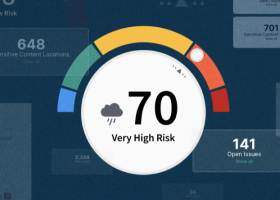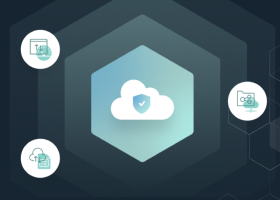Data Management Software Guide
Data management software is a must-have for nearly every organization. Data is, arguably, one of the most valuable assets an organization has. It is used to fuel almost every aspect of an organization’s operations.

Data management software helps harness the power of data while supporting data protection systems. With data management software, organizations ensure access to high-quality, reliable, and relevant information that is readily available to the people and applications that rely on it. It helps to organize, manage, and retrieve digital assets effectively and efficiently.
Data management software solutions are important, because they provide benefits that are integral to smooth, successful operations, including the following:
- Accuracy and integrity
Data must be accurate and consistent for organizations to be able to rely on it to power their operations. Data management software ensures that data is available and accurate—meeting required levels of data integrity. - Flexibility
By supporting the creation and maintenance of clean data, data management software ensures that it is ready to use for whatever is needed. This data flexibility is also enabled with integration. Data management software supports connections to other applications and systems, adding to the flexibility of the data by allowing it to be easily shared between stakeholders (e.g., employees, customers, and partners). - Improved data quality
Data quality dictates the value of data. Data management software makes it easier to create and maintain clean data, which increases its quality. This provides high-quality data for users and applications and ensures that organizations adhere to compliance requirements. - Simplified data management
Data management software facilitates overall database management. With data management software, it is fast and easy to access and use (e.g., share, update, store) data, increasing operational efficiency.
What Is Data Management Software?
Data management software helps organizations:
- Apply policies to identify and manage data throughout its lifecycle
- Enable the easy transfer of data to varying applications, processes, and partners
- Ensure data quality by standardizing data
- Gather and organize data in a centralized repository
- Govern, manage, and consume all shared data assets
- Integrate different sources
- Prepare data for analysis
- Support data security systems and protocols
Among the assets and data formats that data management software houses, organizes, secures, and makes accessible are:
- Financial information
- Graphics
- Internet of Things (IoT) data
- Inventory information
- Mobile data
- Photos
- Social media content
- Videos
Data Management Software Features
Features and capabilities commonly found in data management software include the following:
- Ability to access data on mobile devices
- Access to prebuilt data models
- Aggregation and data security, to ensure data integrity
- Allow access to third-party data sets
- Build databases and begin using applications without coding knowledge
- Centralized data management
- Cleanse data and perform quality checks
- Combine data from different forms into a single file
- Create, edit, and maintain database files and records
- Customize workspace according to individual users’ requirements
- Establish and enforce policies
- Handle different types of queries
- Import and export data from data management platforms in different formats
- Integrate with other applications
- Manage documents
- Meet compliance requirements
- Run analytics
- Search for form submissions and organize data
- Set up and manage granular permissions
- Support collaboration and collaborative workflows
- Use pre-made templates
- Visualize data (e.g., Gantt, calendar, columns, forms, tables, lists)
Data management software also performs other functions, such as:
- Data auditing and tracking
- Data cataloging
- Data governance
- Data integrity
- Data modeling
- Data partitioning
- Data profiling
- Data quality management
- Disaster recovery
- Master data management
- Metadata management
- Taxonomy management
Data Management Software Use Cases
Because data management software allows users to define, integrate, and store data in a centralized location that is easily accessible, it helps organizations:
- Build plans on accurate information
- Enhance data security
- Increase operational efficiency and efficacy by streamlining processes
- Maintain high-quality, accessible data
- Make informed decisions
- Store, find, analyze, and use data
- Work from a data-driven, analytical perspective
Four Foundational Data Management Software Use Cases
Data Warehousing
Data storage is a key function of data management software. Data warehouses require support for loading data using bulk and batch data integration processes. Once the data is ingested, data management software makes it accessible for use in analytics, reporting, and dashboards.
Data Analytics
Advanced data management software can enable real-time analytical processing to expedite time to insight and improve overall operations. This data management software can also support forecasting, predictive modeling, and data mining. In addition, structured and unstructured data (e.g., data generated from IoT devices or machines) can be processed and managed using advanced data management software that employs artificial intelligence and machine learning.
Data Governance
One of the most important use cases with data management software is data governance. Data management software helps organizations successfully balance providing users with the access they need while maintaining the security and integrity of data.
Data management software can support data governance frameworks that are developed to ensure consistent and quality data. Data stewardship roles can also be overseen with data management software.
Data management software plays a key role in compliance management. With increasingly stringent requirements to comply with privacy and other regulations, data management software provides the tools needed to ensure that data usage and storage adhere to the rules.
Selecting the Best Data Management Software
When selecting effective data management software, make sure that it supports:
- Ability to collect data from multiple sources (e.g., online forms, mobile devices, partner systems, internal sources)
- Advanced analytics
- Backup and recovery
- Collaboration
- Data governance
- Guided navigation
- Structured data (e.g., spreadsheets, relational databases) and unstructured data (e.g., social media posts, PDFs, documents, IoT, and machine-generated data)
Before making a data management software selection, consider these questions:
- Can the solution provide visibility wherever the data resides?
- Does the solution work well across on-prem, cloud, and edge use-cases?
- How well does the solution integrate with other applications and systems?
- What forms of media are supported?
- What security is included for protecting data in transit and at rest?
Data Management Software—A Must-Have for Organizations of All Sizes
All organizations are encouraged to use data management software. Data management software helps organizations take full advantage of their data to streamline and simplify most processes by centralizing the management of data assets. From supporting data integrity and quality to providing controlled data access and security, data management software is a juggernaut.
Egnyte has experts ready to answer your questions. For more than a decade, Egnyte has helped more than 16,000 customers with millions of customers worldwide.
Last Updated: 11th May, 2022




